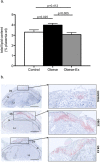Exercise rescues obese mothers' insulin sensitivity, placental hypoxia and male offspring insulin sensitivity
- PMID: 28291256
- PMCID: PMC5349590
- DOI: 10.1038/srep44650
Exercise rescues obese mothers' insulin sensitivity, placental hypoxia and male offspring insulin sensitivity
Abstract
The prevalence of obesity during pregnancy continues to increase at alarming rates. This is concerning as in addition to immediate impacts on maternal wellbeing, obesity during pregnancy has detrimental effects on the long-term health of the offspring through non-genetic mechanisms. A major knowledge gap limiting our capacity to develop intervention strategies is the lack of understanding of the factors in the obese mother that mediate these epigenetic effects on the offspring. We used a mouse model of maternal-diet induced obesity to define predictive correlations between maternal factors and offspring insulin resistance. Maternal hyperinsulinemia (independent of maternal body weight and composition) strongly associated with offspring insulin resistance. To test causality, we implemented an exercise intervention that improved maternal insulin sensitivity without changing maternal body weight or composition. This maternal intervention prevented excess placental lipid deposition and hypoxia (independent of sex) and insulin resistance in male offspring. We conclude that hyperinsulinemia is a key programming factor and therefore an important interventional target during obese pregnancy, and propose moderate exercise as a promising strategy to improve metabolic outcome in both the obese mother and her offspring.
Conflict of interest statement
The authors declare no competing financial interests.
Figures





Similar articles
-
Exercise prevents the adverse effects of maternal obesity on placental vascularization and fetal growth.J Physiol. 2019 Jul;597(13):3333-3347. doi: 10.1113/JP277698. Epub 2019 May 28. J Physiol. 2019. PMID: 31115053 Free PMC article.
-
Exercise in obese female rats has beneficial effects on maternal and male and female offspring metabolism.Int J Obes (Lond). 2015 Apr;39(4):712-9. doi: 10.1038/ijo.2013.150. Epub 2013 Aug 16. Int J Obes (Lond). 2015. PMID: 23949616 Free PMC article.
-
Offspring body size and metabolic profile - effects of lifestyle intervention in obese pregnant women.Dan Med J. 2014 Jul;61(7):B4893. Dan Med J. 2014. PMID: 25123127 Review.
-
Exercise alters the molecular pathways of insulin signaling and lipid handling in maternal tissues of obese pregnant mice.Physiol Rep. 2019 Aug;7(16):e14202. doi: 10.14814/phy2.14202. Physiol Rep. 2019. PMID: 31466137 Free PMC article.
-
The Impact of Maternal Body Composition and Dietary Fat Consumption upon Placental Lipid Processing and Offspring Metabolic Health.Nutrients. 2020 Oct 3;12(10):3031. doi: 10.3390/nu12103031. Nutrients. 2020. PMID: 33022934 Free PMC article. Review.
Cited by
-
A meta-analysis of pre-pregnancy maternal body mass index and placental DNA methylation identifies 27 CpG sites with implications for mother-child health.Commun Biol. 2022 Nov 30;5(1):1313. doi: 10.1038/s42003-022-04267-y. Commun Biol. 2022. PMID: 36446949 Free PMC article.
-
Sex-specific mediating effect of gestational weight gain between pre-pregnancy body mass index and gestational diabetes mellitus.Nutr Diabetes. 2022 Apr 25;12(1):25. doi: 10.1038/s41387-022-00203-5. Nutr Diabetes. 2022. PMID: 35468888 Free PMC article.
-
Sex and gender differences in developmental programming of metabolism.Mol Metab. 2018 Sep;15:8-19. doi: 10.1016/j.molmet.2018.04.007. Epub 2018 Apr 30. Mol Metab. 2018. PMID: 29773464 Free PMC article. Review.
-
Sex-specific effects of maternal metformin intervention during glucose-intolerant obese pregnancy on body composition and metabolic health in aged mouse offspring.Diabetologia. 2022 Dec;65(12):2132-2145. doi: 10.1007/s00125-022-05789-0. Epub 2022 Sep 16. Diabetologia. 2022. PMID: 36112170 Free PMC article.
-
Perinatal Nutritional and Metabolic Pathways: Early Origins of Chronic Lung Diseases.Front Med (Lausanne). 2021 Jun 15;8:667315. doi: 10.3389/fmed.2021.667315. eCollection 2021. Front Med (Lausanne). 2021. PMID: 34211985 Free PMC article. Review.
References
-
- Kral J. G. et al.. Large maternal weight loss from obesity surgery prevents transmission of obesity to children who were followed for 2 to 18 years. Pediatrics. 118(6), e1644–1649 (2006). - PubMed
-
- Smith J. et al.. Effects of maternal surgical weight loss in mothers on intergenerational transmission of obesity. J. Clin. Endocrinol. Metab. 94(11), 4275–4283 (2009). - PubMed
Publication types
MeSH terms
Substances
Grants and funding
- PG/14/20/30769/BHF_/British Heart Foundation/United Kingdom
- FS/09/029/27902/BHF_/British Heart Foundation/United Kingdom
- BB/M001636/1/BB_/Biotechnology and Biological Sciences Research Council/United Kingdom
- MC_UU_12012/4/MRC_/Medical Research Council/United Kingdom
- MC_UU_12012/5/MRC_/Medical Research Council/United Kingdom
LinkOut - more resources
Full Text Sources
Other Literature Sources
Medical
Miscellaneous

